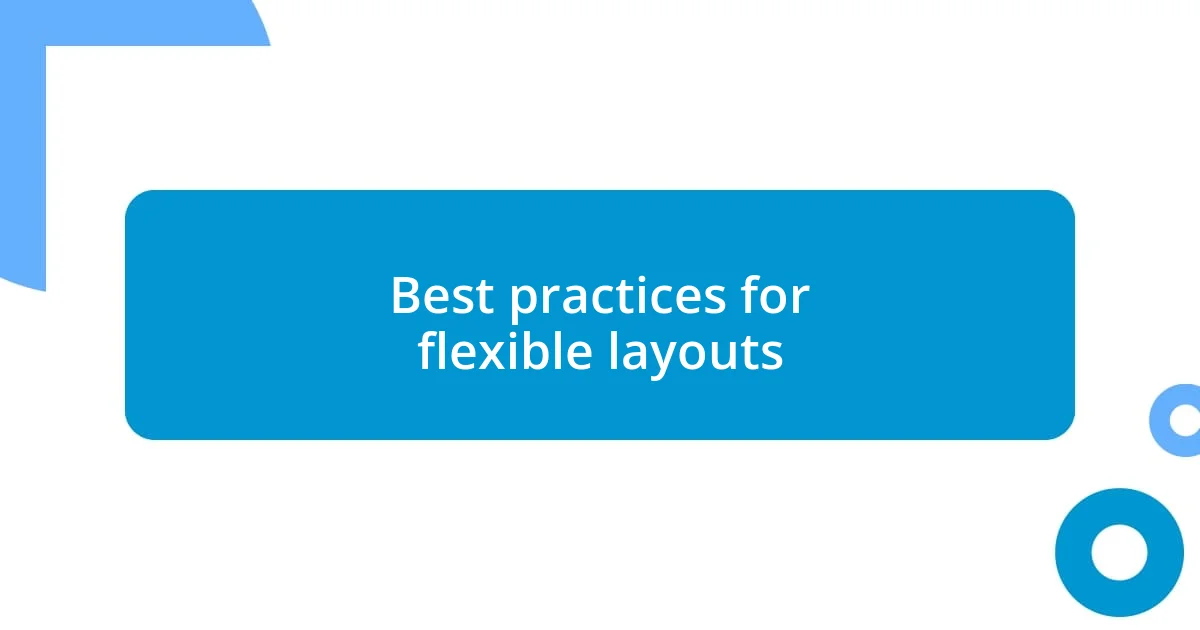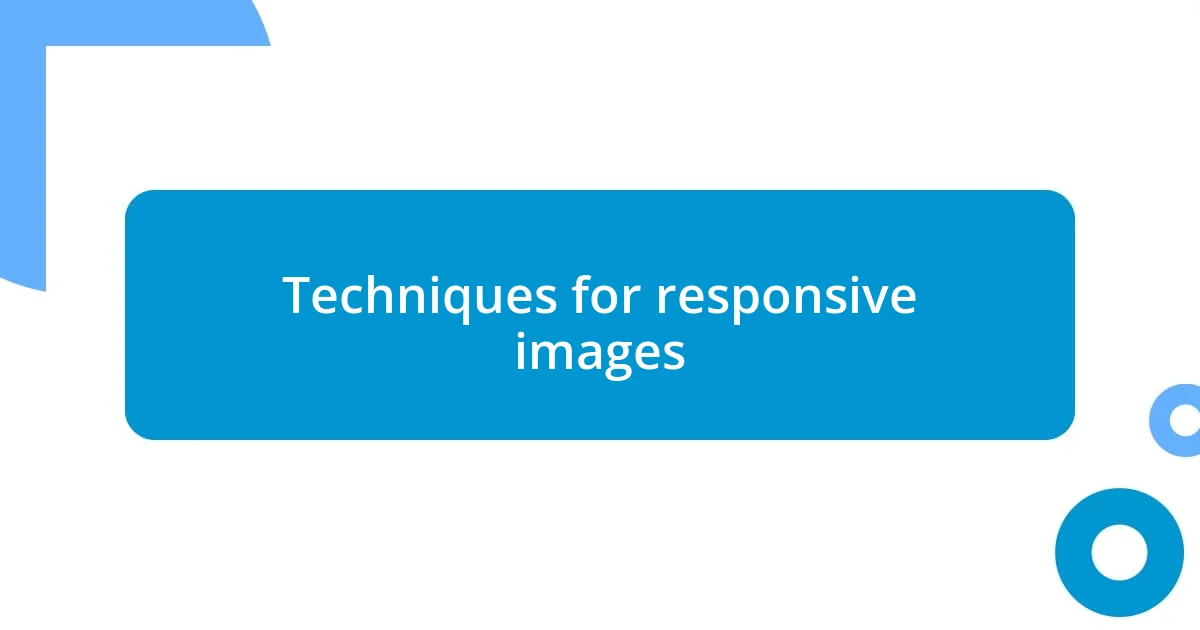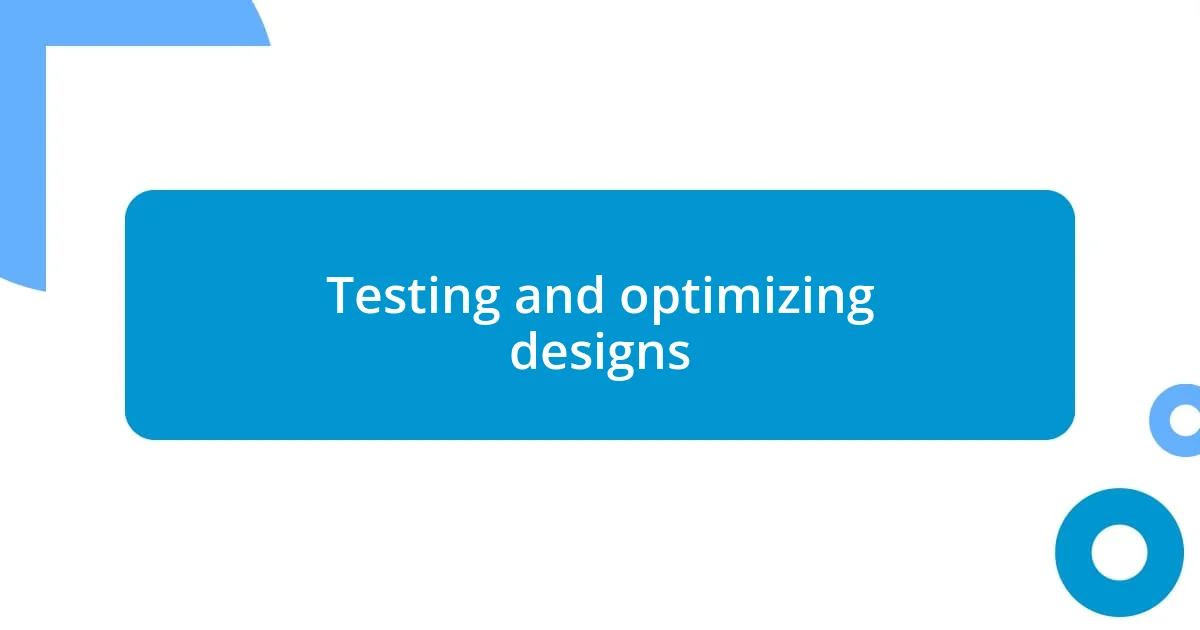Key takeaways:
- Responsive design enhances user experience across devices using flexible grids, media queries, and adaptable layouts.
- Utilizing tools like Bootstrap, Adobe XD, and Google Chrome DevTools streamlines the creation and testing of responsive designs.
- Continuous learning through courses, community engagement, and keeping up with industry trends is vital for mastering responsive design techniques.

Understanding responsive design principles
Responsive design principles are all about creating a seamless user experience across a multitude of devices. I remember the thrill I felt the first time I adjusted a layout that instantly transformed from a cluttered mess on a mobile screen to a sleek, organized display on a tablet. It’s like magic to witness how a thoughtful design adapts to the audience’s context – have you ever tried resizing a browser window, just to see how a site shifts? That moment really struck me.
Another pivotal principle of responsive design is the use of flexible grids and layouts. I once worked on a project where I employed a grid system that could adjust its size based on the viewport width. Watching how the elements reorganized themselves was incredibly satisfying! It’s impactful to think about how this flexibility ensures that content remains accessible and appealing, no matter the screen size.
Lastly, let’s not overlook the power of media queries, which allow your design to respond to specific characteristics of a device. I’ve seen designers shy away from them, fearing complexity. But, in my experience, they have been a game changer. The ability to tailor styles based on device capabilities really elevates the user experience – doesn’t it make you feel connected to your audience when you cater to their specific needs?

Key tools for responsive design
Creating responsive designs efficiently requires the right tools in your arsenal. One of my go-to favorites is Bootstrap. This framework simplifies the process with its powerful grid system and pre-built components. I recall diving into a project and, within hours, I had a mobile-ready layout. The ease of customization made me appreciate how Bootstrap can instantly transform an average site into something sleek and professional.
Another essential is Adobe XD, which I’ve found invaluable for prototyping. Its user-friendly interface allows me to design and make adjustments in real-time, which is crucial when I’m testing responsiveness. I remember a late-night session where I refined a mockup for a client, and seeing the immediate visual changes helped me articulate my ideas more effectively. It’s as if the tool becomes an extension of my creative thoughts, leading to clearer communication and better designs.
Lastly, Google Chrome DevTools can’t be overlooked. This tool is like having a magnifying glass for responsive design. I often find myself testing different screen sizes to see how my designs hold up under various conditions. There was a time when I caught a critical layout error right before launch, preventing a potential user experience nightmare. Knowing you have the right toolbox at your fingertips can make a world of difference – have you experienced that rush when a last-minute tweak saves the day?
| Tool | Purpose |
|---|---|
| Bootstrap | Framework for responsive grid and components |
| Adobe XD | Prototyping and real-time design adjustments |
| Google Chrome DevTools | Testing responsiveness across various screen sizes |

Best practices for flexible layouts
Creating flexible layouts is essential for ensuring that your design can adapt seamlessly to various devices. In my experience, one of the best practices is to use percentage-based widths rather than fixed units. I recall a project where I switched from using pixels to percentages for element widths. The moment I saw the layout fluidly adjust on both my desktop and mobile, I felt a sense of accomplishment that was hard to describe. It’s rewarding to realize how small adjustments can make a big difference in user experience.
Here are some additional best practices to keep in mind for flexible layouts:
- Utilize CSS Flexbox and Grid: These modern techniques allow for dynamic and responsive arrangements of elements.
- Implement Responsive Images: Using the
srcsetattribute ensures images display correctly across different devices without compromising quality. - Test Across Devices: Nothing beats real-world testing. I often use friends’ devices to see how my designs perform in different contexts.
- Embrace Breakpoints: Strategically placing breakpoints helps to maintain a coherent layout as the viewport changes.
- Prioritize Content: By determining which content is most crucial, I can ensure it displays correctly on all device sizes without overwhelming the user interface.

Techniques for responsive images
When it comes to responsive images, one approach I find invaluable is using the srcset attribute. This allows me to define multiple image sources for different resolutions and screen sizes. I remember working on a project where high-resolution images were crucial for brand identity. By implementing srcset, I was able to deliver crisp visuals on larger displays while also optimizing load speeds on mobile devices. It’s empowering to give users the best experience possible, isn’t it?
Another technique I swear by is the use of CSS’s max-width property. This simple yet effective rule keeps images from stretching beyond their container’s width. I once had a mishap where a hero image stretched awkwardly on a small screen, completely ruining the aesthetic. Once I applied the max-width: 100% rule, the image adjusted beautifully, and I could breathe a sigh of relief. Have you ever felt the tension of a design mishap that spiraled into a simpler solution? It’s moments like that which highlight the beauty of responsive design.
Finally, I pay close attention to file formats. Using WebP images, for instance, has been a game-changer for me. When I transitioned to this format, I saw significant reductions in loading times without sacrificing quality. Every percentage of performance counts, especially when waiting for images can turn potential customers away. Reflecting on that experience made me understand that the right technique doesn’t just enhance appearance; it also directly impacts usability and satisfaction. How about you? Have you explored different image formats to optimize your designs?

Media queries for adaptability
Media queries are the backbone of responsive design, allowing me to tailor styles based on a device’s characteristics, like its width or orientation. I still remember the first time I successfully implemented media queries; it felt like unlocking a new level in my design journey. I created specific styles for mobile views, and seeing my designs adapt so beautifully was incredibly satisfying. Have you ever experienced that eureka moment when your code transforms a design?
One important aspect I’ve learned is the power of breakpoint strategy. I often find myself pondering, “Where should I set my breakpoints for maximum impact?” Establishing breakpoints at around 768px for tablets and 1024px for desktops has served me well. During a live project, I realized that using too many breakpoints led to a clunky experience. Simplifying my approach not only streamlined my code but also enhanced the user experience. Wasn’t it surprising how a little less complexity resulted in clearer adaptability?
I also love the flexibility media queries bring through conditional loading of styles. One project I worked on involved a complex dashboard that needed to accommodate both mobile users and desktop users. By utilizing media queries, I was able to change the layout completely for smaller screens while keeping it information-dense on larger ones. It was rewarding to engage with users later on and hear their feedback about how intuitive the design felt, regardless of the device. If you’ve faced challenges adapting a design for various screens, don’t hesitate to embrace media queries—they can truly revolutionize your approach!

Testing and optimizing designs
When it comes to testing and optimizing designs, I often turn to tools like Google Lighthouse and browser developer tools. These resources have helped me pinpoint performance issues that I wouldn’t have noticed otherwise. I remember a situation where I ran a Lighthouse audit on a project and discovered unnecessary JavaScript slowing down the load time. It felt like unearthing hidden treasure as I optimized those scripts and improved the overall user experience. Have you ever taken a moment to dive deep into your projects and discovered something that transformed your design?
Another vital step for me is user testing. I typically gather feedback from real users who interact with my designs. One memorable instance was when I observed users struggling to navigate a mobile version of a site I had crafted. Their frustration was palpable, and it pushed me to rethink my layout and ensure the buttons were more accessible. Seeing my designs through users’ eyes helps me refine and tailor my work in ways I might otherwise overlook. Have you engaged users directly to uncover insights that can enhance your design?
Lastly, I’ve found that A/B testing can be incredibly illuminating. By creating two versions of a design element—say, a call-to-action button color—I can determine which one resonates more with users. Once, I tested a bright green button against a subtle blue one, surprised to find the blue variant performed significantly better. It was a real eye-opener for me in understanding how small details can influence engagement. Have you embraced A/B testing as part of your design process, or do you rely more on instinct?

Continuous learning and improvement strategies
Continuous learning is an essential part of mastering responsive design techniques. I remember the first time I dove into an online course on advanced CSS. It felt like every lesson unlocked a new tool in my toolkit. The more I learn, the more I realize how much there is still to discover. Have you ever felt that surge of excitement when grasping a new concept that can elevate your work?
Another strategy I embrace is joining design communities and attending workshops. Engaging with fellow designers has opened up countless avenues for knowledge exchange. I recall an inspiring workshop where peers shared their unique approaches to responsive challenges. The collaboration sparked ideas in me that I hadn’t even considered before. Have you connected with others in the field to broaden your perspective and skills?
Staying up-to-date with industry blogs and podcasts is also key for my continuous improvement. I make it a habit to dedicate time each week to read about emerging trends and tools. There’s something invigorating about discovering cutting-edge practices; I often find myself eager to experiment as soon as I learn something new. What resources do you rely on to keep your skills sharp?














